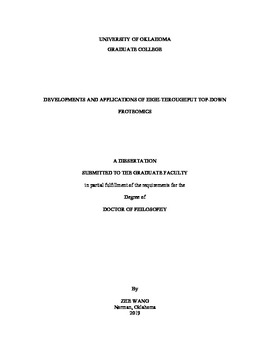| dc.description.abstract | Emerging technologies for liquid chromatography (LC) separations and mass spectrometry (MS) have dramatically improved the throughput of top-down proteomics, which has allowed the identification of thousands of intact proteoforms in complex biological samples. Many proteins have multiple intact proteoforms (i.e. variants with different post-translational modifications, PTMs) and these proteoforms often exhibit differing functions in biological processes. Therefore, it is important to establish an accurate and high-throughput top-down approach for the analysis of intact proteoforms. The focus of this dissertation is the development and application of novel high-throughput quantitative top-down proteomics techniques to characterize intact proteins in complex biological samples (e.g., serum autoantibody repertoire).
We have developed a two-dimensional separation platform for high-throughput top-down MS analysis, which employs high-pH and low-pH RPLC-MS for top-down proteomics. The high-pH and low-pH 2D RPLC has been widely applied in bottom-up proteomics; however, it has not been applied to intact protein separation. Our results demonstrated that the proposed high-pH and low-pH RPLC separation format has good orthogonality for intact protein separation. We have used our 2D Ph RP/RPLC platform for PTM characterization of complex biological samples such as E. coli and human cell lysates. This ‘salt-free’ RPLC process overcomes the disadvantage of other chromatographic methods, which require complicated sample processing (i.e., buffer exchange, desalting) before MS analysis, and the two dimensions of separation could be easily coupled for online analysis.
One of the drawbacks of the platform is that a large amount of starting material is required and the sample handling process between each dimension can introduce variations in the sample and can cause loss of sensitivity due to sample loss during the transfer, recovery, and desalting processes. Moreover, the off-line multidimensional separation techniques are often time consuming, labor intensive, and low-throughput. To improve the throughput and sensitivity of the offline approach, we developed an online 2D ultra-high-pressure nano-LC system for high-pH and low-pH RPLC separation in top-down proteomics. The online 2DLC platform enabled the characterization of 2000+ intact proteoforms from 5 micro-grams of intact E. coli cell lysate, presenting a potential for deep proteome characterization in mass-limited samples using top-down proteomics.
The human serum autoantibody repertoire is extremely complicated and autoantibody development is crucial to the function of the human immune system. We have applied top-down MS methods to characterize the serum autoantibody repertoire. We implemented a 1D UPLC-TDMS platform and achieved separation of a mixture of 12 antibody Fabs with highly homologous sequences. Furthermore, we characterized 86 Fab related mass features, which represents the first top-down analysis of the complexity of the human autoantibody repertoire. Using top-down proteomics techniques, the PTMs of monoclonal antibodies can also be characterized; this information could give valuable insight into autoantibody function and human immunity.
Antibody-antigen interaction is the fundamental reaction of immune system. The clear characterization of paratope/epitope of an immune complex can help the understanding of immune response and possibly the mechanisms of related diseases. To characterize the immune complexes, we coupled a low-temperature LC system with hydrogen/deuterium exchange mass spectrometry (HDX-MS), and applied it to characterize the epitopes of the protective antigen.
Overall, our results demonstrate the utility of top-down proteomics for the analysis of the serum autoantibody repertoire and application of HDX-MS on immune complex characterization. Top-down proteomics techniques hold great promise for the discovery of novel serum autoantibody biomarkers, as well as the promotion of our understanding of pathogenic autoimmune processes. | en_US |

